A Brief History of Perry Hall
By David Marks
Historian, Perry Hall Improvement Association
Edited by Linda Mickey Perruso
Hundreds of years ago, northeastern Baltimore County was explored by nomadic Indians who came south from present-day Pennsylvania to hunt for game in the bountiful Chesapeake Bay region. These tribes were dominated by the terrifying Susquehannocks, who intimidated smaller Indian clans and held dominion over the area until Europeans settled Maryland in the Seventeenth Century. The Susquehannocks moved frequently through Perry Hall, using present-day Joppa Road as a trail to the west.
Captain John Smith encountered the Susquehannocks in 1608 when he made the first European exploration of the Gunpowder River. Smith’s expedition cleared the way for intense industrialization along the Gunpowder River, and by the Eighteenth Century, northeastern Baltimore County was the site of numerous mills, furnaces, and forges. A small settlement emerged near present-day Cowenton and Joppa Roads, home to woodcutter families who lived in log cabins and sod houses.
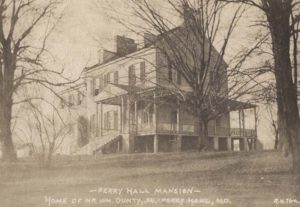
The Perry Hall Mansion
These squalid conditions contrasted vividly with the mansion being constructed in the northern region of Perry Hall. In 1774, wealthy planter Harry Dorsey Gough purchased a 1,000 acre estate called “the Adventure” north of present-day Belair Road. Gough renamed the estate “Perry Hall,” after his family’s home in Great Britain, and completed construction of the Perry Hall Mansion, which still stands in the northern part of our community. Harry Dorsey Gough, then, could be thought of as the founder of Perry Hall.
The Gough family dominated the life of the community until after the Civil War. The Gough plantation was among the largest in Baltimore County, and Harry Dorsey Gough was an early leader in the Maryland General Assembly, as well as a founder of the Methodist Church. It was at Perry Hall Mansion that plans for the American Methodist Church were developed by Gough, Francis Asbury, and other religious leaders. The Gough family later donated land for the construction of the Camp Chapel church and a community school.
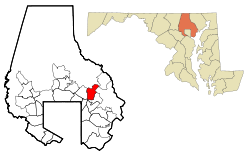 With German and Irish immigration, new Catholic and Lutheran churches were built in the community. For most families, entertainment meant gathering together on the front porches of the farmhouses, where families would hold dances and young men would romance the girls from down the street. In time, the name “Germantown” disappeared from local maps, and the plantation moniker “Perry Hall” came to distinguish the growing village.
With German and Irish immigration, new Catholic and Lutheran churches were built in the community. For most families, entertainment meant gathering together on the front porches of the farmhouses, where families would hold dances and young men would romance the girls from down the street. In time, the name “Germantown” disappeared from local maps, and the plantation moniker “Perry Hall” came to distinguish the growing village.
Early Exploration and Settlement
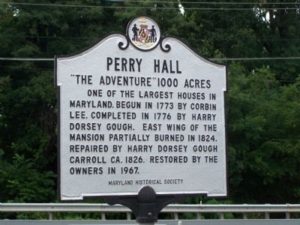
Perry Hall Marker
On June 16, 1681, George Lingdan of Calvert County acquired the 1,000 acres of land now known as “Perry Hall.” Lingdan called his property “The Adventure.” A subsequent 500-acre addition over the Gunpowder River was called “Adventure’s Addition.”
Harry Dorsey Gough: The Founder of Perry Hall
More than any other person, Harry Dorsey Gough dominated life in Perry Hall during the early history of the community. He owned most of the land, controlled local commerce, and built the mansion, high atop one of the town’s steepest hills, which would give the community its identity. By almost any measure, Harry Dorsey Gough must be thought of as the founder of Perry Hall.
Harry Dorsey Gough (pronounced like “rough”) was born on January 28, 1745 in Annapolis. His family was steeped in aristocracy, social status, and wealth. Thomas Gough, his father, was from a wealthy English family, had immigrated to Maryland by 1745, and built a house a mile from Patapsco Ferry. His mother was Sophia Gough, daughter of the wealthy Caleb Dorsey of Hockley, on the Severn River. Harry Dorsey Gough was their only child.
In 1770, Gough began acquiring thousands of acres of land extending for three miles on both sides of present-day Belair Road. By 1775, shortly after the death of Corbin Lee, Gough had purchased “the Adventure,” including the mansion which was constructing before his death. Gough renamed his estate “Perry Hall,” after his family’s castle in Staffordshire, England. He was living in Perry Hall Mansion in 1774 when his horse, Garrick, won thirty pounds for Gough at a race in Joppa. A record of that race identifies the winner as “Harry Dorsey Gough of Perry Hall.” Our classmate Bill Dunty is the great grandson of William Dunty Jr who owned the Perry Hall Mansion from 1894-1915.
In March of 1776, Gough met Francis Asbury, an early leader of the Methodist Church in America. They became good friends, and later that year, the young minister converted Gough and his wife to Methodism. It was a defining moment in Gough’s life. The sportsman and gentleman-farmer, who loved entertainment and his country estate, became a devout Methodist, more contemplative and deliberative in his actions. Gough actively supported the young Methodist movement, generously donating his wealth and property for the cause. In 1808, Asbury would write that “Mr. Gough had inherited a large estate from a relation in England, and having the means, he indulged his taste for gardening and the expensive embellishment of his country seat, Perry Hall, which was always open to visitors, especially those who feared God.”
Perry Hall and the Methodist Church: 1784-1850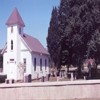
Perry Hall’s roots are intertwined with those of the American Methodist Church. Since 1766, our community has been known as “the cradle of Methodism,” a place of holy significance for Methodists throughout the United States. It was here that the Methodist Church of America was formally organized in 1784, when Christian leaders met at Perry Hall Mansion to design a new nationwide religion.
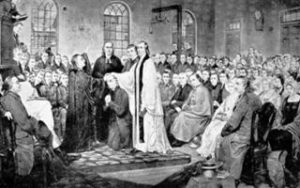
Harry Dorsey Gough
Postcard showing the Christmas Conference of 1784, where Methodism was organized. Harry Dorsey Gough is seated in the left hand corner. Prudence Gough, wife of Harry Dorsey Gough, is dressed in white and seated in the first row.
Perry Hall in the Early Nineteenth Century
“Germantown,” named for the industrious immigrants who cultivated the remains of the Gough estate. The village was centered at the intersection of Forge and Belair Roads. Interestingly, the 1877 atlas of Baltimore County identifies our community only as “Germantown,” although that name has since faded from use. Today, Germantown has merged into the greater Perry Hall community, and its founding families are known as Perry Hall’s eldest citizens–people like the Butts, Klausmeiers, Dietzes, Ryes, Hubers, and Kahls.
Many of Perry Hall’s first families are still here, although most of the farms have since been divided or developed. Our major streets bear many of their names, including those of the Klausmeier, Penn, and Soth families.
Perry Hall in the 1960s and 1970s
In the early 1970s, when the Baltimore Sun wanted to profile the typical Maryland suburb, they came to Perry Hall, “a great place for growing up: or old.” In a January 1973 article in their Sunday magazine, the newspaper claimed that “Perry Hall has a lot to offer: plenty of open space, grass and trees, fresh air, a real small-town sense of living, and few crowds, drugs, noise and pollution to fight.” One resident even called his quiet home town “perfect.”
Photograph of intersection of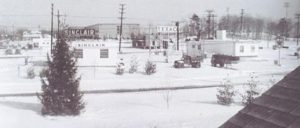
Belair and Joppa Roads, Winter 1966-67.
(Courtesy William Dunn, Perry Hall, Maryland)
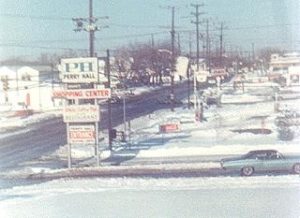 Back then, the community’s biggest problem was a crowd of teenagers who loitered around Perry Hall Shopping Center at night. This was one of two shopping centers in the community, with a Pantry Pride, bowling alley, Woolworth’s, and later a Rustler Steakhouse. Sometimes, when the police chased the teenagers away from the shopping center, they converged at Berg’s Dairy or Gino’s. Gino’s, a popular drive-in eatery, burned down in the early 1980s, then became a Roy Rogers, a Hardees, and finally a Popeye’s restaurant.
Back then, the community’s biggest problem was a crowd of teenagers who loitered around Perry Hall Shopping Center at night. This was one of two shopping centers in the community, with a Pantry Pride, bowling alley, Woolworth’s, and later a Rustler Steakhouse. Sometimes, when the police chased the teenagers away from the shopping center, they converged at Berg’s Dairy or Gino’s. Gino’s, a popular drive-in eatery, burned down in the early 1980s, then became a Roy Rogers, a Hardees, and finally a Popeye’s restaurant.
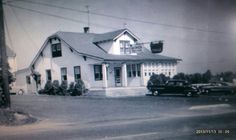
Berg’s Dairy Farm
Perry Hall offered one of the best recreation programs in Baltimore County, with more than 3,500 youngsters participating in softball, soccer, roller skating, and other activities. That was quite a turnout, considering Perry Hall’s tiny population of 7,000 residents.
For all of these growing pains, though, Perry Hall was still relatively undeveloped beyond the Joppa/Belair/Ebenezer Road intersection. Seven Courts Drive was a landing strip for small airplanes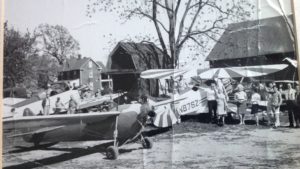 (Spamers Airport), with cow pastures and Berg’s dairy farm stretching northward to the Gunpowder River. Ebenezer Road was still a country path, with the new Perry Hall High School, built in 1968, hidden among a dense grove of trees. White Marsh was still a collection of farms and mining quarries. For residents of Parkville and Carney, Perry Hall was almost a rural backwater, a country village at the corner of suburbia.
(Spamers Airport), with cow pastures and Berg’s dairy farm stretching northward to the Gunpowder River. Ebenezer Road was still a country path, with the new Perry Hall High School, built in 1968, hidden among a dense grove of trees. White Marsh was still a collection of farms and mining quarries. For residents of Parkville and Carney, Perry Hall was almost a rural backwater, a country village at the corner of suburbia.
Perry Hall Roots
Perry Hall’s first families cleared the land, building forges and mills by the mighty Gunpowder River. They were poor families, yet their spirits were tempered by a devout faith in Methodism, a young religion which had its American roots in Perry Hall. Methodism bridged the gap between rich and poor in our tiny village. The Gough family, wealthy proprietors of Perry Hall Mansion, donated land and funds for the construction of a community church and school. Early residents knew it was a distinctive spirit of warmth and camaraderie, one which would unite the community through the Twentieth Century.
Perry Hall has not lost that spirit. Its presence is strongest in our churches and schools. In the midst of change and development, the themes of family and local pride run strong in Perry Hall, as they have since Harry Dorsey Gough founded his family estate in 1775 and industrious immigrants cleared the land after the Civil War. Some things never change.
Names of Perry Hall Places
Perry Hall’s founding families lent their names to places in our community. Hines and Klausmier Roads, as well as Baker and Ferguson Lanes, were named after families which immigrated to Perry Hall largely during the early Nineteenth Century. Soth Avenue was named after the Soth Farm, which was across from present-day Perry Hall Elementary School on Joppa Road. Halbert Avenue is named after “the Halbert Half Way House,” which was demolished when the Perry Hall library was built in 1963. Darnall Road owes its name to the original 1683 land grants, “Darnall’s Sylvania” and “Darnall’s Camp 1000 Acres.” When this area of central Perry Hall was developed, great care was made to distinctively identify the original history of the neighborhood.
Perry Hall’s Schools: The Heart of the Community
Every December, hundreds of families gather in front of Perry Hall Elementary School for a special occasion. With the flick of a switch, that cold December evening is suddenly transformed by a spectacular burst of color and light. The Perry Hall Christmas tree is lit for another season, proclaiming holiday cheer to all friends and visitors along Belair Road.
Perry Hall is fortunate to have some of the best schools in Baltimore County. It’s a tradition that began in 1723, the first time that the state funded public education.
That year, the Maryland General Assembly authorized funds for each county to buy 100 acres of land, construct a school, and hire a teacher. The headmaster received only twenty pounds a year–about $50 annual salary by today’s standards. Baltimore County’s school was built in Loreley, near the forges on the Great Gunpowder River. This location is now known as Allender Road.
Scholars Plains Free School, as it was known, taught students from Perry Hall until about 1784. English, arithmetic, and surveying were standard courses. With limited state funding, the school was unable to afford the costs of teaching a growing, yet very poor, group of children. The school closed in 1784, and for over sixty years, children were either taught by their parents or by local churches like Camp Chapel or St. Joseph’s.
In 1857, the Scholars Plains land was sold. The money received was used to build two new schools, one for whites and another for black children. Although the original buildings were replaced, both schools operated separately until 1960.
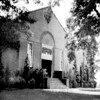 The first school within Perry Hall’s boundaries was built at Belair Road and Horn Avenue, near the present-day Friendly’s restaurant. It was a small log cabin built in 1874 to serve the children of those European immigrants settling the community. After this burned down, Harry Dorsey Gough Carroll, one of the last of his family to occupy Perry Hall Mansion, donated an acre of land for a new school. Here, at the intersection of Forge and Belair Roads, the community built a three-room brick school. This site was used for almost sixty years. It is now the location of Schimunek’s Funeral Home.
The first school within Perry Hall’s boundaries was built at Belair Road and Horn Avenue, near the present-day Friendly’s restaurant. It was a small log cabin built in 1874 to serve the children of those European immigrants settling the community. After this burned down, Harry Dorsey Gough Carroll, one of the last of his family to occupy Perry Hall Mansion, donated an acre of land for a new school. Here, at the intersection of Forge and Belair Roads, the community built a three-room brick school. This site was used for almost sixty years. It is now the location of Schimunek’s Funeral Home.
In 1925, the Baltimore County School Board decided to construct a new community school on David Dannenfelser’s property near the intersection of Belair and Joppa Roads. Perry Hall School opened three years later, and more than any other structure, it served as the nucleus of the community for most of the Twentieth Century.
In 1956, classes mostly shifted to the new Perry Hall Elementary School, but the building served as an annex due to overcrowding from 1956 through the late 1970s.
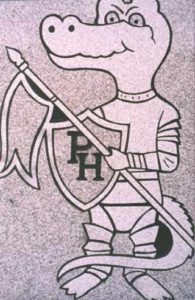
The Perry Hall Mascot
The 24-room Perry Hall Elementary School opened in 1956. At that time, older students attended classes in Kenwood. Seven years later, Perry Hall Senior High School opened, although it was then located in the current middle school. Perry Hall Senior High School opened at its current site in 1967, and the old building became Perry Hall Junior High School. For many years, Perry Hall was one of the few communities where its three public schools were located on the same street, as children became older, they simply moved down Ebenezer Road.
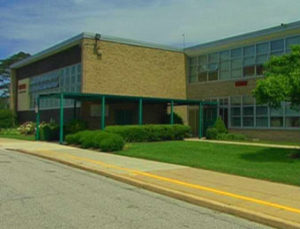 The three original public schools have a lot of history and lore. Perry Hall High School, for example, was built on property donated by Jacob Seddon in 1850. The Seddon family lived in the East Joppa Road house which now includes the Honeygo Child Development Center. They maintained a burial plot at the high school site. Today, the Seddon cemetery rests in the field immediately behind the tennis courts and main parking lot.
The three original public schools have a lot of history and lore. Perry Hall High School, for example, was built on property donated by Jacob Seddon in 1850. The Seddon family lived in the East Joppa Road house which now includes the Honeygo Child Development Center. They maintained a burial plot at the high school site. Today, the Seddon cemetery rests in the field immediately behind the tennis courts and main parking lot.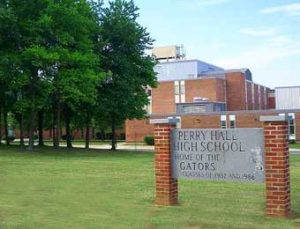

Churches and Cemeteries in Perry Hall
Camp Chapel United Methodist Church is the oldest house of worship in Perry Hall. During the War of 1812, parishioners gathered at this site.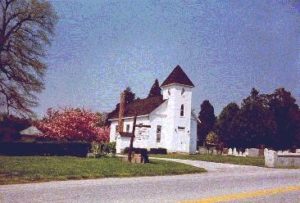
Perry Hall’s religious ancestry is Methodist. It was at Perry Hall Mansion that plans for the Methodist Church of America were developed by Francis Asbury, Harry Dorsey Gough, and a handful of early Methodist leaders. These pioneers helped start Camp Chapel Church, which provided religious instruction for the woodcutter families near the Gunpowder River. Camp Chapel was followed by Perry Hall United Methodist Church in 1866.
St. Joseph’s Roman Catholic Church began in 1850. First services were held in the Krastel farmhouse near Fullerton. The Krastel family donated a tract of land for the church near their home on Buck’s Schoolhouse Road. When this became too small, the growing parish bought fourteen acres on Belair Road for a permanent site, paying only $200 for a tract of land on Perry Hall’s western border. The church was finished in 1870. It was used continuously until 1971, when the current building was completed. Bells from the original parish are displayed in back of the main hall.
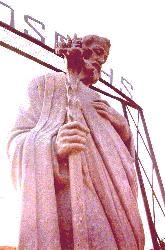
Photograph of the Statue at St Josephs Church
Perry Hall has other holy places. There are about half a dozen cemeteries scattered throughout Perry Hall, and those are the ones we know about: many of our earliest settlers left no headstones or burial markers.
There are two small cemeteries off Ferguson Road. One of these is the Chambers family burial ground, where one of the original trustees of Camp Chapel Church, Daniel Chambers, is buried. Another is Rocky Rest, the burial ground for the Spamer family, which has been well maintained by members of the family for several decades. This is located near Hickory Falls Way, on top of one of the highest hills in Perry Hall.
Notable Homes in Perry Hall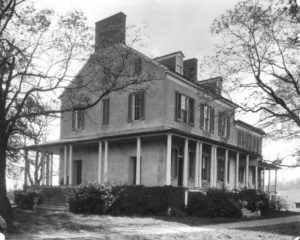
The oldest standing home in our community is Perry Hall Mansion, which rests on a secluded five-acre property near the Gunpowder River. Built in 1773, the mansion is now one of the last remaining colonial homes in Maryland. From here, Harry Dorsey Gough supervised his vast 1,000-acre estate, “Perry Hall,” which stretched across most of the northern part of our community. The spacious, sixteen-room mansion was partially burned by fire in 1824, but was soon restored, remaining in the Gough family until 1875. It was then purchased by Eli Slifer of Philadelphia. Slifer divided the property into farms of various sizes, selling the estate to immigrant families, many of whom were of German descent. The mansion still stands, nestled in a grove of trees in the rural reaches of Perry Hall.
After he and his wife were converted to Methodism, Gough devoted his funds to religious work, building a small chapel adjacent to the mansion. Although this has since been destroyed, Gough was instrumental in the development of Camp Chapel Church, which still stands on East Joppa Road.
Another old house is the Spamer residence. It is not known who built the small stone residence on Ferguson Road, but Daniel Chambers purchased the property in 1827 and named it “Rockland”. The ten-room house was bought by Elmer J. Spamer in 1881. Five generations of the Spamer family have since lived there.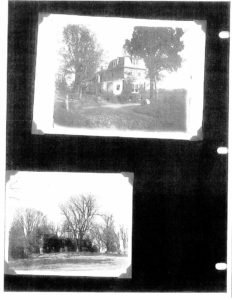
There are two stone houses along East Joppa Road, near Honeygo Run, which date back to at least the early Nineteenth Century. The Moore family residence was built in 1852 by John Moore. It is now surrounded by the family’s orchards, on the east side of Chapel Hill Elementary School. Another old structure is the Jacob Seddon house, its architecture dates back to before the Civil War. It is one of the oldest houses in Perry Hall.
Two other homes are worth noting, although both have long since been demolished. Bishop’s Inn was a stage coach stop, a bakery, a butcher shop, and a hotel. Another notable home, since demolished for the Perry Hall library, was Halbert Mansion.
The old house that stood at 9200 Belair Road was said to be older than Perry Hall Mansion. This was the center of Linden Farm. The farm was named for a huge Linden tree originally brought from England by John Darnall. Both the house and the tree were demolished many years ago. This property later became Lassahn Field.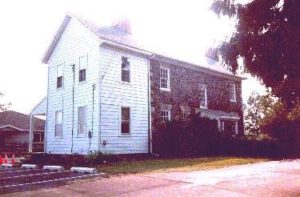
Documents
Baltimore County Land Records: DEEDS to The Perry Hall Mansion
1775 January 16 : Archibald Buchanan to H. D. Gough -1000a. “The Adventure” (4.85 mb)
1852 May 24 : Harry D. G. Carroll to William M. Meredith
1866 November 09 : William M. Meredith to Eli Slifer (13.4 mb)
1888 February 29 : Gertrude G. Biddle, et al. Deed to William Dunty Sr. (2.53 mb)
1894 March 12 : William Dunty Sr. to William Dunty Jr.
1915 July 13 : William Dunty Jr. to George F. Bucholz (18.91 mb)
1916 July 19 : George F. Bucholz to Sarah A. W. Coursey
1918 August 03 : Sarah Coursey to Mercantile Trust
1919 January 9 : Mercantile Trust to Harry A. Shackelford
1924 December 30 : Harry A. Shackelford to Joseph W. Plumer
1948 November 03 : Joseph W. Plumer to George Ray Bryson
1950 June 06 : George Ray Bryson to John B. Gontrum
1950 November 02 : John B. Gontrum to Gordon L. Smith
1953 September 01 : Gordon L. Smith to Benjamin H. Kaestner
1966 October 05 : Benjamin H. Kaestner to Thomas W. Mele
1995 April 13 : Thomas W. Mele to Thomas W. Mele II
2001 December 12 : Thomas W. Mele II to Baltimore County Maps
1857 Map of Baltimore County (22.3 mb) or Enlargement of Perry Hall (2.91 mb)